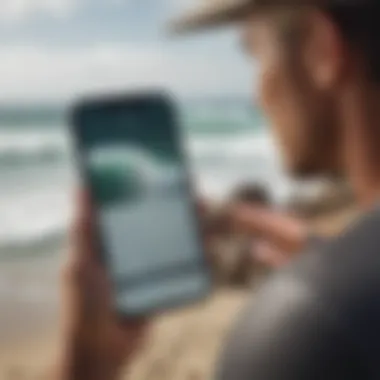Essential Surf Forecast Apps for Every Wave Rider


Intro
In recent years, surfing has transformed into more than just a sport; it’s a way to connect with nature and a lifestyle for many. But whether you're a seasoned wave rider or a curious beginner, understanding the ocean's capricious nature is crucial. That's where surf forecast apps come into play. These handy tools are not just optional accessories; they are your compass in navigating the unpredictable waters of surfing.
The significance of these applications cannot be overstated. They provide real-time data about wave conditions, tides, and wind patterns, making it easier for surfers to plan their outings. With a plethora of apps available, each claiming to offer the best forecasts, it can be overwhelming to choose the right one. But grasping the fundamentals of how these apps function can greatly enhance your surfing experience, aiding you in picking the most suitable app tailored to your unique preferences.
By tapping into environmental data and harnessing technology, surf forecast apps play a pivotal role in surf culture. They help surfers of all proficiency levels make informed decisions, ensuring they catch the perfect wave. In the following sections, we’ll delve into vital components of surf gear, essential accessories, techniques and skills that pair seamlessly with these apps, creating a holistic understanding of the modern surfing experience.
The Necessity of Surf Forecast Apps
When catching waves, knowledge is power. Surf forecast apps have risen to prominence in the lives of surfers everywhere, and for good reason. These tools go beyond mere forecasts; they play a vital role in planning your surf sessions, mitigating risks, and enhancing enjoyment of the sport. With the proper application, a surfer can navigate the often unpredictable nature of the ocean, ensuring their time on the water is as productive as possible.
Understanding the Role of Technology in Surfing
In today’s fast-paced world, technology shapes almost every aspect of our lives, and surfing is no exception. Surf forecast apps utilize sophisticated algorithms and real-time data to provide surfers with vital information about ocean conditions. For instance, real-time satellite imagery can show wave sizes, swell direction, and water temperature, offering insights that were once only available to seasoned ocean veterans.
With mobile apps like Surfline and Magicseaweed making waves in the digital space, surfers now have the ocean at their fingertips. These tools not only quantify the surf but also analyze factors like weather reports, wind patterns, and tide schedules. Thus, technology has made surfing more accessible, allowing surfers from all backgrounds and skill levels to make informed decisions.
Whether you are a pro tearing through the swells or a newbie just learning to balance on your board, having up-to-date information can be the difference between a great day on the waves and a washout.
How Accurate Forecasting Enhances the Surfing Experience
The adrenaline rush of surfing largely depends on the conditions, which is why accuracy in surf forecasting can’t be overstated. Accurate predictions can ensure that surfers hit the water when conditions are prime, making each ride exhilarating. For example, a forecast that predicts a larger swell can motivate surfers to hit the beach early, allowing them to enjoy the tubes while they last.
Moreover, surf reports aren’t just numbers; they can influence the plans of surfers, families, and surf schools so they can all enjoy their time on the water. When surfers can plan their trips with precision, they minimize the chance of disappointment. It’s like showing up at a restaurant known for its five-star reviews only to find it closed! By leveraging technology, surfers can make the most out of the ocean’s rhythm.
"Accurate forecasting brings clarity to the chaos of the sea, allowing surfers to ride more than just waves; they ride a wave of confidence."
The nuances of surf forecasting also lead to a stronger connection among the surfing community. With many apps including social features, surfers can share conditions, current reports, and even videos of their rides. This fosters a collective culture, where surfers not only enhance their individual experiences but build bonds that reinforce the surfing lifestyle.
Key Features to Look for in a Surf Forecast App
When it comes to surfing, the right app can be like having a trusty guide by your side, steering you toward those perfect waves. But what are the key features that make a surf forecast app truly indispensable? Surfers at all levels should pay heed to specific elements that can mean the difference between a mediocre session and one for the books. Here’s a look at some crucial characteristics to consider when choosing a surf forecast app.
Wave Height and Period Predictions
As a surfer, understanding wave height and period is fundamental to planning your surf outing. Wave height information, given in feet or meters, indicates how lofty those waves will be. But it's not just about size; wave period—the time interval between consecutive waves—is equally important.
- Accuracy and Timeliness: Forecasts need to be spot-on. If an app says you'll get 6-foot waves, you want to show up and find just that. Two-foot waves won’t get your adrenaline pumping.
- Modeling Technologies: Different apps use various modeling techniques to predict wave conditions. Some rely on buoy data, while others incorporate complex atmospheric models. Researching these can give you a leg up when choosing an app.
- Visualizations: Apps that provide visual maps or graphs of wave height over time allow surfers to better anticipate when the surf will be at its best.
Keeping your eyes peeled for these features can lead to better wave-catching experiences.
Wind Conditions and Their Impact on Surfing
Wind can make or break your surf session. While many surfers know that offshore winds can create cleaner, more rideable waves, the type and speed of wind can often get overlooked. An effective surf app should help surfers anticipate how wind conditions will impact wave quality.
- Wind Speed: An understanding of how strong the winds will be can inform you whether you want to paddle out or wait for calmer conditions.
- Wind Direction: Knowing whether wind is coming from the north, south, east, or west can greatly affect surf conditions. Many apps now show wind direction in real-time, which can influence when and where to surf on any given day.
Including wind data in your planning can truly elevate your surfing experience. The right information here can spell the difference between a fun day at sea or battling messy conditions.
Tide Information and Its Importance
Tides, driven by the moon and sun, have a significant effect on surf breaks. Many surfers prioritize tide charts just as much as they do wave forecasts. Here’s why tide info is essential:
- Optimal Conditions: Certain breaks only work well at specific tide levels. An app should provide not just high and low tide times, but also the tide heights.
- Local Knowledge: An app with localized tide data can provide insights unique to specific surf spots. What works for one beach may not apply to another.
- Tide Charts: Visual representations of tides help surfers easily identify peak surfing times in advance.
Tide-related features can illuminate when you should hit the water for the best chances of scoring those sweet rides.
"Having all the factors in place—wave conditions, wind speeds, and tides—allows surfers to glide into thrilling moments that define their love for the sport."
In essence, a surf forecast app isn’t just a handy tool; it’s your co-pilot in what could be the most exhilarating ride of your life. Keep an eye out for these key features to ensure you’re always ready for your next big wave adventure.
A Comparative Analysis of Popular Surf Forecast Apps
In the world of surfing, being in sync with the waves is paramount. With a plethora of surf forecast apps available, it's crucial to dive into a comparative analysis of these tools. This examination not only helps in discerning which apps stand out but also illustrates how they cater to varying surfer needs. A comprehensive comparative analysis provides insight into functionalities, ease of use, and the unique benefits each application brings to the table. By dissecting these apps, surfers can make informed decisions about which tools are best suited for their wave-riding adventures.
Overview of Leading Apps in the Market
Surf forecast apps vary widely in their offerings, but a few have consistently earned the heads-up among enthusiasts. Some of the most notable apps include:


- Surfline: Known for its robust predictive tools and extensive network of live surf cam feeds.
- Magicseaweed: Offers detailed surf reports along with community-driven insights.
- Windy: While focused more on wind conditions, it provides a thorough overview that surfers appreciate.
- MSW (Magic Seaweed): A different version of Magicseaweed with unique algorithms for wave prediction.
- Surf Forecast: This app provides simplified forecasts ideal for casual surfers.
Each app brings a combination of local knowledge and technological prowess to help riders pluck from the ocean’s best offerings.
Strengths and Weaknesses of Each Application
Understanding the strengths and weaknesses of these popular applications can empower surfers to pick the right fit. Here’s a closer look at some key players:
Surfline
Strengths:
- Comprehensive live reporting with a large network of webcams.
- Detailed forecasts including swell height and period.
- Offers premium features such as personalized surf alerts.
Weaknesses:
- Some features are only available to premium members, limiting access for occasional users.
- The interface can feel overwhelming for novices.
Magicseaweed
Strengths:
- User-friendly interface with community-driven reviews.
- Offers long-term forecasts that are beneficial for planning trips.
- Free access with an array of features.
Weaknesses:
- Forecast accuracy can vary across different regions.
- Occasionally slow performance due to traffic during peak surf seasons.
Windy
Strengths:
- Real-time wind and weather data essential for surfers.
- Visually appealing and easy to navigate with interactive maps.
Weaknesses:
- Lacks specific surf-related metrics which some may find limiting.
- Focused more on environmental data rather than just waves.
Surf Forecast
Strengths:
- Simplistic design, suited for beginners.
- Offers a quick snapshot of surf conditions.
Weaknesses:
- Lacks the depth of detail found in more comprehensive apps.
- Limited community features for insights from fellow surfers.
By weighing these strengths and weaknesses, surfers can tailor their choice according to experience level and specific needs. Every surfer has their preference, and understanding these nuances can lead to more enjoyable and safer surf outings.
User Experience: Evaluating Interfaces and Usability
In the realm of surf forecast apps, user experience (UX) is paramount. Apps must deliver concise and easily digestible information, enabling surfers to navigate conditions effortlessly. A well-designed interface can significantly enhance the overall effectiveness of the app, transforming data into actionable insights. When discussing usability, the focus should be on how surfers from different backgrounds interact with these apps.
Surfers, whether rookies or seasoned pros, have varied expectations from their forecast tools. A user-friendly app minimizes frustration and maximizes satisfaction. Elements such as the design, responsiveness, and intuitive navigation are essential. Complicated interfaces can lead to information overload, causing users to jump ship for alternatives. Conversely, a clean layout, coupled with straightforward navigation, allows surfers to hone in on the vital details without unnecessary distractions.
Navigating App Interfaces Effectively
When surfers engage with an app, the interface is their first touchpoint. An effective interface is trimmed to the essentials. Users shouldn’t have to hunt for wave height or wind conditions. Filters and tabs help streamline content. For instance, displaying the most pertinent data upfront ensures surfers won't miss crucial info, like sudden weather changes that might affect their surf session.
Consider the use of color coding for different surf conditions—greens could denote perfect riding weather while reds indicate dangerous conditions. This simple visual cue instantly communicates critical information.
Furthermore, the searchability within the app enhances user efficiency. Whether a surfer is hunting for local breaks or general tide info, easy access to a search feature can speed up the process. A well-structured FAQ section could also serve as a great ally—addressing common queries can elevate overall satisfaction and minimize user frustration.
Personalization Options for Tracking Preferences
Personalization in surf forecast apps is becoming increasingly essential. Surfers like to tailor their experience, focusing on what matters most to them—be it specific spots, wave types, or even certain weather conditions. Options for customizing alerts can make a world of difference. For example, a user could set notifications for when waves reach a particular height or when wind speeds align with their preferences.
Using geolocation features enables surfers to receive forecasts and alerts tailored to their current or favorite breaks. Apps can leverage geographic data to send tailored recommendations and updates. Similarly, the ability to save favorite locations adds a personal touch, allowing users to pivot their attention to beloved surf spots with ease.


In addition, charts and graphs can be customizable, letting users prioritize certain data points like swell direction or tide levels. When users see the exact information they need in a format they prefer, it fosters a more emotionally-healthy relationship with the app.
In summary, a seamless user experience combined with robust personalization options enhances the way surfers plan their sessions.
These features not only serve practical purposes—they nurture a bond between surfers and their digital tools, ultimately enriching the surfing experience.
Integration of Environmental Data in Surf Forecasting
In the realm of surfing, where conditions can shift faster than the tides, integrating environmental data into surf forecasting has become a key component. These apps not only provide wave heights but also analyze a myriad of other relevant factors, enriching the surfing experience. The inclusion of environmental data allows surfers to make informed decisions, enhance safety, and ultimately elevate their time on the water. Having access to real-time information enables them to grasp how these elements intertwine with wave riding.
The benefits of utilizing environmental data in surf forecasting include:
- Improved Accuracy: By using various environmental indicators, like temperature, humidity, and wind patterns, forecasts become more precise, helping surfers know when to make their move.
- Enhanced Safety: Understanding the changing weather can prevent dangerous situations, guiding surfers to steer clear of adverse conditions.
- Optimal Planning: Knowing how tides, currents, and local weather can influence surf quality allows surfers to pick the right spots and times for riding.
In essence, surf forecast apps that incorporate comprehensive environmental data are crucial for today’s surfers, offering them a holistic view of the conditions they recommend.
The Importance of Real-Time Data
Real-time data is the bread and butter of surf forecasting. When events occur—like sudden wind changes or a storm brewing—this information can be relayed instantly. A strong, clear offshore wind can drastically improve the surf, while an unexpected downpour might end the session early.
"Mere hours can change the face of the surf, and real-time updates offer surfers the chance to seize the moment."
Surfers who rely on updates from these apps can adjust their plans virtually on a dime, heading to a nearby beach that’s about to light up with ideal conditions. Without real-time data, they'd be missing the boat on potentially perfect waves.
How Weather Changes Affect Surf Quality
Weather plays a pivotal role in surf quality. Even small shifts can create a chain reaction affecting everything from wave size to water temperature.
- Barometric Pressure: Changes in pressure can signal swells coming in or moving out, impacting wave heights and shapes.
- Wind Direction: Winds can create either clean, well-formed waves or choppy, unpredictable surf. Onshore winds typically lead to messier conditions, while offshore winds can transform the sea into a surfer’s playground.
- Rainfall and Storms: Heavy rain could mean reduced visibility and murkier waters. While some regions may see improved swells from storms, others might present unsafe conditions.
For example, a surfer heading out just as a storm passes might be greeted with thrilling waves. However, they must be cautious of ensuing dangerous conditions as the storm changes. Understanding these nuances allows surfers to navigate their chosen sport with respect for the environment and a mind for personal safety.
Surf Forecasting Techniques and Technologies
Surf forecasting techniques and technologies are the backbone of what makes modern surfing so exhilarating. In a nutshell, these tools allow surfers to spend more time on the waves and less time guessing. With the ocean being an unpredictable entity, having a reliable method to predict wave behavior is essential for any surfer, whether they are a seasoned pro or just finding their feet on the board. The integration of various technologies has transformed the way surfers approach the sport, making it more accessible and enjoyable.
Understanding Wave Modeling and Predictions
At the heart of forecasting is wave modeling. This involves using complex algorithms to analyze various data points and predict how waves will behave. For instance, information about wind speed, direction, ocean currents, and atmospheric pressure all come into play when calculating potential surf conditions.
A key benefit of wave modeling is the use of simulations that depict how waves will break at different spots along the coastline. By doing this, surfers can compare spots and choose the best location for their session. More than just numbers, these models provide insights into how waves interact with each other, leading to conditions that can change in minutes.
It's crucial for surfers to grasp not just the numbers but the science behind them. A good app allows surfers to visualize wave height and other metrics over time, which helps them develop an intuition for what conditions unfold.
"As they say, no surf, no fun. But with solid forecasting, surfers can make the most of every session."
Satellite Technology and Its Contributions
Satellite technology plays a monumental role in surf forecasting. Equipped with advanced sensors, satellites capture detailed images of the ocean's surface, including wave patterns and ocean temperature. This data is invaluable. It allows forecasts to include information about swell generation far out at sea, meaning surfers can prepare for conditions before they even hit the beach.
One significant contribution of satellite technology is the ability to monitor vast areas of ocean. With this capability, surfers gain insights into storms and swells approaching their favorite spots, enabling fine-tuned planning.
Moreover, satellite data enhances accuracy in forecasting for various coastal regions. Rather than relying solely on models fed by local buoys and weather stations, satellite images provide a broader picture of ocean dynamics.
When surfers know that a storm system is creating swells somewhere offshore, they can plan their outings accordingly, ensuring they ride the best waves while minimizing the risk of disappointment.
In a nutshell, the combination of wave modeling and satellite observations empowers surfers to make more informed decisions, aligning their surf trips with optimal conditions. This results in a richer engagement with the sport and a deeper appreciation for the nuances of the ocean.
The Community Aspect of Surf Forecast Apps
In surfing, it’s not just about the waves but also about the people you ride them with. This reality is mirrored in the world of surf forecast applications. These apps do more than simply deliver weather updates or wave predictions; they serve as platforms for surfers to connect, share experiences, and cultivate a sense of community. Each feature and option available in these applications is designed with the user in mind—a fact that’s often overlooked.
Connecting Surfers Through Shared Information
One of the cornerstones of any surf forecast app is the ability to foster connections among surfers. When a user reports conditions at their local break, they're not just sharing a social media status; they're contributing essential information that can guide decision-making for other surfers. Such shared data can include wave quality, crowd sizes, and even wildlife sightings. For instance, a surfer on the beaches of Malibu might input that the waves are clean at sunrise, while another in North Carolina might note choppy conditions due to a sudden squall. This real-time information becomes a valuable resource, allowing fellow surfers to make informed choices about where to paddle out.
"Community in surfing feeds the soul; sharing makes waves feel more alive."
In essence, these shared updates build a sophisticated network of knowledge, where everyone plays the role of both student and teacher. But the benefits extend beyond just surf conditions. Surfers can also share tips about local surf spots or discuss safety concerns like riptides. This holistic approach to information sharing transforms the surfing experience from a solitary quest into a vibrant conversation, enriching everyone involved.


User-Generated Reports and Their Value
User-generated reports are the lifeblood of many surf forecasting apps. These reports not only help enhance the accuracy of forecasts but also provide insights that professional meteorological models might miss. When surfers take the time to report their observations, they bring a layer of nuance that algorithms alone cannot capture. For example, a report may indicate that while the forecast predicted 6-foot waves, local conditions reveal actual wave heights were at 4 feet, with a notable lack of current.
The value of user-generated content lies in its authenticity. It's one surfer's voice among thousands that adds richness to the app's offerings. This peer-to-peer interaction engages users more deeply, encouraging a participatory culture where everyone is somewhat responsible for keeping the data current and reliable.
- Local Insights: Knowledge about hidden surf spots can often be found in users' comments. These insights help level the playing field, giving newcomers a chance to discover gems that seasoned veterans have guarded closely.
- Safety Alerts: Users can report dangerous conditions, such as unexpected changes in tide, further enhancing safety for the entire community. These alerts are invaluable to both novice and experienced surfers, reminding users that even seasoned athletes need to stay vigilant.
- Photo Sharing: Many apps offer functionality for sharing photos of conditions. A clear picture can say a thousand words, showing potential surfers what they can expect before they head out.
Thus, the community aspect of surf forecast apps not only enhances the surfing experience but also transforms how surfers interact with each other and their environment.
The interconnectedness fostered by these apps encourages a spirit of collaboration, ensuring that every surfer—whether a rookie or a pro—can ride the waves with knowledge and confidence.
Future Trends in Surf Forecast Technology
The surfing landscape is transforming, and technology plays a pivotal role in steering this evolution. Understanding future trends in surf forecast technology not only enhances the wave-riding experience but also ensures that surfers, whether newbies or seasoned pros, can optimize their time on the water. With advancements on the horizon, the possibilities seem as vast as the ocean itself, promising to reshape how surfers interact with the waves.
The Role of AI and Machine Learning in Forecasting
Have you ever wondered how surf forecast apps can predict the perfect wave? This is where the marvels of artificial intelligence and machine learning come into play. Unlike traditional models, which might rely heavily on historical data and rigid algorhythms, AI has the potential to analyze a plethora of data points in real-time. This includes satellite images, ocean temperature, and wind patterns, allowing for highly accurate predictions.
Imagine waking up and checking your app, only to find that it indicates prime surfing conditions just three hours down the coast. That’s AI doing its magic. With machine learning, the more data these apps collect, the better they become at forecasting. They adapt and refine their predictions, learning from past storms, tides, and user interactions. A system that evolves, much like the waves themselves, presents a promising future for surfers everywhere.
Evolving Features to Anticipate for Users
As surfers dive deeper into the digital age, the features of surf forecast apps are rapidly evolving. What can users expect in the coming years? Here are some notable trends:
- Personalized Alerts: Imagine getting notifications tailored to your specific surfing preferences, like your favorite break or ideal wave height. Future apps will likely offer customizable alerts that ping you when conditions are just right.
- Community Integrations: Surfing is as much about community as it is about the waves. Look forward to features that allow surfers to share real-time conditions, tips, or even videos of sessions, fostering a sense of camaraderie.
- Enhanced Visualization Tools: Some apps might integrate augmented reality, giving users an immersive view of wave conditions before they even hit the beach. Picture standing on the shore, pointing your phone toward the surf, and instantly getting data visualizations of the waves rolling in.
- Biometric Feedback: This futuristic feature may track your surfing performance through wearables, providing insights on your ride, including speed and technique, thus marrying tech with physical exertion seamlessly.
Safety Considerations When Using Surf Forecast Apps
In the world of surfing, excitement often coexists with risk. When engaging in this exhilarating sport, it's crucial to be aware of the potential hazards that can accompany a day on the waves. Surf forecast apps serve as magnificent tools for surfers, yet they also bring forth a need for caution. Understanding the limitations and exercising personal judgment can make a considerable difference in ensuring a safe surfing experience.
Understanding Limitations of Forecasts
While surf forecast apps provide valuable insights, it’s vital to remember that they rely on predictive algorithms and data interpretation. These tools utilize historical and real-time information to estimate conditions like wave height, wind speed, and tide. However, the ocean is a complex and ever-changing environment. Just because an app projects nice, manageable waves doesn’t guarantee that’s the state of the ocean when you arrive.
There are several factors that these forecasts might not account for:
- Microclimates: Localized weather effects can significantly alter conditions, leading to back-to-back sunny forecasts with sudden storm surges.
- Human Error: Misinterpretation of the data by the user can lead to underestimating risks or overconfidence in the surf conditions.
- Dynamic Nature of the Sea: Waves can change quickly depending on numerous variables, including wind shifts and ocean currents.
Because of these elements, surfers must maintain a healthy skepticism about app predictions. It's wise to refrain from solely relying on technology without cross-referencing with other information sources, like local surf reports or firsthand observations.
The Importance of Personal Judgment in Surf Conditions
Even with the most advanced technology at our fingertips, nothing takes the place of instinct and personal judgment. As seasoned surfers often say, "When in doubt, paddle out with caution." Relying on one’s own experience and observations is where the art of surfing truly shines.
Here are some practical aspects to consider:
- Local Knowledge: Understanding the unique characteristics of your home surf spot helps in making informed decisions based on wave patterns, prevailing conditions, and local weather nuances.
- Physical Form and Skill Level: Assessing one's capabilities is just as important. Even if conditions seem favorable, it’s essential to ask oneself if you are suited for those waves. If they look way beyond your skill set, you might want to reconsider.
- Buddy System: Surfing with friends can enhance safety. They can provide additional perspectives on conditions, watch for dangers, and assist if something goes awry.
"The ocean is a powerful teacher; it demands respect and understanding. Always remember, no app can replace common sense."
Given the myriad of variables in nature, no amount of forecasting can guarantee perfect conditions for every surfer at every moment. Thus, heavily relying on personal judgment—cultivated through experience and situational awareness—is paramount to experiencing the ocean safely and enjoyably.
By integrating both the technological insights from surf forecast apps with individual knowledge and instincts, surfers can carve out a safer and more thrilling experience on the waves.
Culmination: The Impact of Surf Forecast Apps on Surfing Culture
The rise of surf forecast apps marks a significant shift in surfing culture. These applications are no longer just tools for enthusiasts; they have become integral to how surfers engage with their environment. Understanding how these apps impact the surfing community provides clarity into their role in the sport's evolution.
Summarizing the Key Insights
Throughout this article, key aspects have been outlined regarding the utility of surf forecast apps. Surfers now have access to a wealth of information at their fingertips. Whether it’s in-depth analyses of wave heights, current wind conditions, or tide patterns, these apps deliver data that can modify plans on a whim.
- Increased Accessibility: The democratizing factor of these apps is noteworthy—anyone with a smartphone can now participate in informed surfing.
- Real-Time Data: Surfers can leverage real-time updates about changing conditions, leading to better decision-making on whether to hit the waves.
- Community Engagement: Many of these platforms foster a sense of community, providing spaces where users share their experiences and reports. This connectedness can enrich the surfing experience, offering shared knowledge that goes beyond what any individual surfer could gather alone.
The benefits are clear; these apps bridge the gap between surfers and the ocean. Having precise information changes how one experiences the sport, potentially leading to safer and more fulfilling outings.
Encouraging Informed Surfing Decisions
Though users may be wooed by the convenience these apps provide, it’s crucial to apply skepticism and judgement in using them. While surf forecast apps can enhance awareness, no technology replaces human intuition and experience.
Consider the following points:
- Limitations of Data: Understanding that forecasts are not guarantees is vital. Conditions can change rapidly, and what appeared calm and inviting an hour ago may evolve into something far less predictable.
- Trusting Your Judgement: It’s essential for surfers to rely on their experience and perceptions of the water. Technology can provide information, but it shouldn’t cloud natural instincts developed through years of surfing.
- Continuous Learning: Regularly checking updates and acknowledging shifts in conditions is part of becoming an informed surfer. Users can build skills over time, learning to interpret data through practical experience in the surf.















